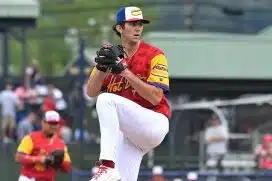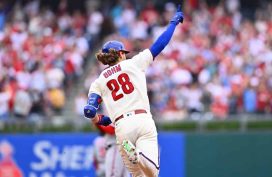By: Jason Ferrie, Sports Talk Philly Columnist
Philadelphia Phillies RHP Vince Velasquez ended his spring on Monday with another stellar performance against the Toronto Blue Jays.
The 24-year-old and his team will head north to start their 2017 campaign with high hopes as the Phillies look to push towards .500, two years after posting the worst record in the league. A big part of that hope relies on their starting rotation and Velasquez himself, who is coming off his first 20-start season in the majors. This spring the young right-hander finished with a 19.2 inning pitched, a 2.75 earned run average and 25 strikeouts. If the Phillies are going to improve in 2017, they will need Velasquez to sustain his spring performance while continuing to add onto his arsenal of pitches.
If you have watched Vince Velasquez pitch, then it should come as no surprise that he has a big fastball and will generate a lot of strikeouts with it. Last year, Velasquez featured his four-seam fastball or sinker 64.88-percent of the time. It was easily his most comfortable combination of pitches, especially when featuring a four-seam fastball that averaged 94.7 miles per hour. Per Brooks Baseball, 99 of Velasquez 152 strikeouts came via the four-seam fastball (65-percent). The number of fastballs he threw along with the fact that he threw them often in two strike counts show the confidence he has in the pitch. The chart below, provided by Baseball Savant, represents the counts and percentages for counts in which Velasquez threw a four-seam fastball.
As the chart displays, Velasquez threw his fastball over half of the time in counts with two strikes—which is fine—but there needs to be another pitch that will keep a hitter off balance. There is no doubting a 95 mile-per-hour fastball that generates swings and misses like Velasquez’s, but if it becomes predictable, you could find some trouble.
For reference, here is a display of the pitch distribution and outcomes for Velasquez last season, per Brooksbaseball:
|
Results and Averages – from 01/01/2016 to 01/01/2017 |
|||||||||||||
|
Pitch Type |
Count |
AB |
K |
BB |
HBP |
1B |
2B |
3B |
HR |
BAA |
SLG |
ISO |
BABIP |
|
Fourseam |
1221 |
277 |
99 |
29 |
0 |
45 |
10 |
0 |
11 |
0.238 |
0.394 |
0.155 |
0.329 |
|
Sinker |
211 |
40 |
9 |
8 |
0 |
7 |
2 |
0 |
1 |
0.25 |
0.375 |
0.125 |
0.3 |
|
Change |
271 |
59 |
12 |
4 |
0 |
13 |
2 |
1 |
3 |
0.322 |
0.542 |
0.22 |
0.364 |
|
Slider |
282 |
61 |
15 |
3 |
1 |
8 |
6 |
0 |
3 |
0.279 |
0.525 |
0.246 |
0.326 |
|
Curve |
221 |
52 |
15 |
0 |
0 |
10 |
3 |
0 |
3 |
0.308 |
0.539 |
0.231 |
0.382 |
As we can see, the lowest averages and slugging percentages come against Velasquez’s four-seam and sinker—which explain his common use of the pitches, especially the four-seam.
There are two issues for Velasquez as he enters this year, one being his health and the other pitch development. We will start with the later, and as the chart displays, the young Velasquez certainly struggled with his off-speed pitches last season. When the opposition is slugging over .500 against any certain pitch, there should be some serious concern.
Velasquez is aware that he needs to develop his secondary pitches, specifically his curveball. This spring he admitted that he needed to improve saying, “It was a good pitch to use, but I didn’t really use it as much as I should have.” For reference, Velasquez used his curveball 13.6-percent of the time in 2016.
Velasquez went on to say:
“I really didn’t command it as much. I’m trying to lock in on one target and try to hit that every time. I utilized it a lot in the off-season in bullpens. I’m trying to master it as much as I can. I know it’s a good out pitch to use, but I also have a high percentage of getting guys out with my regular fastball. If I can move up and down in the zone, getting ahead of guys and putting guys away with it, then I’m definitely going to use it.”
This quote is true and as the numbers above represent, it accurately reflects the style of Velasquez. The Phillies love the confidence that Velasquez has in his fastball, but he will absolutely need to develop another pitch to become a top of the rotation type arm. The guy to go to for Velasquez has been Jeremy Hellickson, who averaged 2970 RPM on his curveball—which was the 13th best in baseball last season. Along with an elite spin rate, Hellickson limited opposing hitters to a .213 batting average and .326 slugging percentage against his curveball last season.
In a recent interview with Dan Plesac, Velasquez discussed his curveball and some of the off-season adjustments that he has worked on. In the video, Velasquez discussed moving to a spike curveball, which is what Jeremy Hellickson throws. Along with that, Velasquez discussed adjustments in terms of his stride length when delivering the pitch. These are two areas to focus on as Velasquez will feature a spike grip that should get more bite, and it will eliminate the sweep he gets from time-to-time with the traditional two-finger grip. The two-finger curveball grip would sometimes allow Velasquez to get around the ball and create a sweeping break, rather than the 12-6 he is looking to generate.
This curveball is going to be key for Velasquez to take the next step and get closer to the ceiling the Phillies believe he possesses. The other key is going to be his health. At the end of last year, the Phillies had to sideline their young flame thrower due to arm issues. In 2010, Velasquez had Tommy John surgery—which he has obviously bounced back from in the recent years. Prior to being traded from Houston to Philadelphia, there were some concerns surrounding the shoulder of Velasquez—yet another thing to keep in mind heading into this season.
We have also not seen a full season of Velasquez which is something he needs to prove he can handle before the Phillies put too much confidence in him being a staple at the top of their rotation. Including a lone performance in Double-A last season, Velasquez threw 136 innings—which is the most he has thrown at any level in his young career. There is no doubting his fastball and potential upside, but the Phillies should keep all options open until Velasquez can prove that he can handle this workload.
The Phillies will need Velasquez to be the pitcher was in the first half of last season while continuing to add to his arsenal if they want to have a chance at a .500 record. Velasquez presents the Phillies with a young, talented power arm that has a high ceiling. The main issues with Velasquez are the lack of secondary pitches and health, both of which he will try to correct this season.







